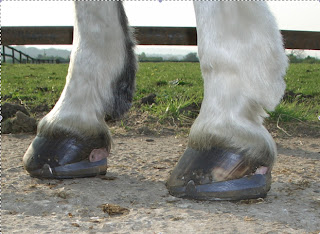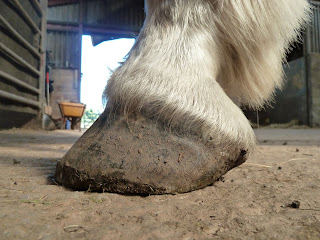This is him in March, with his first set of wedges, which improved his lameness.
By April he was in a double set of wedges, which long term I suspect would have caused all sorts of back problems, given the effect its having on his stance. As it happened, they didn't stay on long anyway as Dillon not surprisingly pulled them off.
By June he was in these wedges - a sort of halfway house between the single and double wedges but which again weren't a long term solution.
For comparison here is the same foot about a week after his shoes came off (above) and today (below).
Not an enormous change, but more structure to the caudal hoof and a better stance.
A sole shot of the LF shows how that stronger caudal hoof is developing - from day one above to today - still a weak foot but improved frog structure and the start of a healthier hoof.
Dillon was unusual as he arrived with a heel first landing, but as you can see from his footage, it was a rather unnatural and exaggerated movement in front and his hinds legs were landing flat/toe first and sliding.
Dillon from Nic Barker on Vimeo.Four weeks later his movement is better - heel first on all four feet and still with a good stride length.
St Swithin's day if thou dost rain
For forty days it will remain
St Swithin's day if thou be fair
For forty days 'twill rain nae mair
Happy St Swithin's day to everyone and the weather today on Exmoor is.....well, its not raining, and I think it might be a lovely day, so here's to the rest of the summer :-)
BTW, for all those who doubt the St Swithin's Day saying, even a meteorologist admits that, although it can't be taken literally, "the perpetrators of the sayings surrounding St. Swithin's Day during the Middle Ages were obviously aware that summer weather patterns are usually quite well established by mid July and will then tend to persist until late August, a fact backed up by the fact that similar sayings exist around the same time of year in Belgium, the Netherlands, Germany and France."

















No comments:
Post a Comment